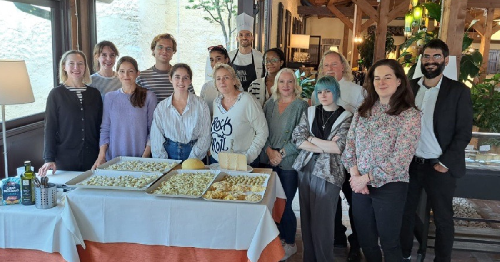In October, The Staff Canteen joined a group of food writers on a press tour to Parma, Italy — organised by Parmigiano Reggiano and Brand Dialogue — for a few unforgettable days celebrating one of Italy’s most iconic ingredients.
From start to finish, it was a trip filled with flavour, craftsmanship, and passion. Every stop offered a new insight into why this region is so special — and why Parmigiano Reggiano deserves its reputation as the “King of Cheeses.”
Our first evening set the tone at Ai Due Platani, where every plate felt like an embrace. Parma ham, Parmigiano, handmade pasta, and beautiful wine — all simple but perfectly executed. It was one of those meals where conversation paused regularly so everyone could just appreciate what was on the plate.
The next morning, we headed to Caseificio Bertinelli in Noceto, one of the dairies within the Parmigiano Reggiano consortium, during Caseifici Aperti (“Open Dairies”). Here, we learned how milk, salt, and rennet — just three ingredients — became golden wheels of Parmigiano Reggiano. There was something mesmerising about the process, even in its simplicity. The most striking detail? The cheese can only be made once a day because the milk can’t be refrigerated, and the cows are milked twice daily. Every wheel is handmade and carefully matured for years until it develops that unmistakable flavour and crunch.
Of course, we couldn’t leave without tasting it — from young, buttery one-year Parmigiano to the rich, nutty, three-year-old version with those iconic little protein crystals. Tasted side by side, it was like a masterclass in time itself.
From there, we travelled to Parma Rotta restaurant for a pasta-making masterclass with chefs Antonio Di Vita and Frederico Palo. Rolling, shaping, filling — and inevitably laughing — we learned to craft traditional pasta before sitting down to enjoy the fruits of our labour for lunch. There’s something incredibly satisfying about eating pasta you’ve just made, especially when it’s cooked to perfection and paired with local wine.
That evening, Croce di Malta restaurant reminded us why Parma’s food scene is so renowned — more incredible dishes, more flawless flavours.
The following day took us beyond cheese to another PDO treasure: Culatello di Zibello. We visited the curing cellars at Al Vedel, where just eight people — all from the same family — have carried on the craft across generations. No preservatives, only meat and salt, and even the pigs’ diet includes Parmigiano cheese as a sweetener. The meat hangs to dry for up to 48 months, developing a rich, complex aroma that’s unique to the region’s microclimate. The attention to detail was astounding: each cured leg is tapped with a small hammer to test its readiness, and when it’s finally ready to eat, it spends three days soaking in water and white wine to soften.
Our final evening meal at Cortex restaurant was a fitting finale — modern, elegant, and full of surprises. The standout dish? A single onion. Yes, just an onion — but handled so skilfully that it was rich, sweet, and layered with flavour. Proof, if ever there was, that in Italy, simplicity and technique go hand in hand.
The trip was an incredible reminder of what makes the Emilia-Romagna region such a culinary heartland. It wasn’t just about seeing how things are made — it was about meeting the people behind the products, sharing stories over good wine, and tasting the results of generations of pride and passion.
We left Parma with a full heart (and stomach), a deeper appreciation for Parmigiano Reggiano, and the sense that I’d experienced something truly special — a celebration of craftsmanship that connects every part of Italian food culture, from the dairy to the dining table.


Dining and Cooking